In the Edwardian era, it was generally considered healthy to sweat. If a person didn’t sweat enough, they were advised to do more gymnastic exercises, go into the sun and fresh air. But the Edwardians were as sensitive about sweat as we are today: In society, sweat should never be seen or smelled. So, even if there weren’t many antiperspirant, there were perfumes, perfumed body powders, and perspiration powders to mask the body odor. Some of the following recipes were used alone, and some in combination with dress shields to protect the dress.
Perfume
Lily Perfume (Henley’s Twentieth Century Formulas, Recipes And Processes, 1916)
- 8 oz tuberose oil
- 2 oz rose oil
- 2 oz cassie oil
- 1 oz jasmine oil
- 1 oz neroli oil
- 1 oz spirit of rose
- 1 oz tincture of vanilla
- 2 minims bitter almond oil
Lily Of The Valley Perfume (Henley’s Twentieth Century Formulas, Recipes And Processes, 1916)
- 1,500 parts vanilla flower oil
- 800 parts rose oil
- 800 parts neroli oil
- 750 parts acacia oil
- 750 parts jasmine oil
- 15 parts bitter almond oil
Lavender Water (The White House Cook Book, 1899)
- 2 oz lavender oil
- 1/2 oz orris root
- 1 pint spirits of wine
‘Mix and keep two or three weeks. It may then be strained through two thicknesses of blotting-paper and is ready for use.’
Cologne Water (The White House Cook Book, 1899)
- 2 drachms lavender oil
- 1 1/2 drachms rosemary oil
- 1 drachm orange oil
- 1 drachm lemon oil
- 1 drachm bergamot oil
- 2 drachms essence of musk
- 10 drops rose oil
- 1 pint proof-spirit
‘Shake all together thoroughly three times a day for a week.’
Otto Of Roses (The Cyclopædia of Practical Receipts in All the Useful and Domestic Arts, 1841)
‘Steep the rose buds or leaves in pure water, and collect the floating oil.’
Essence Of Violets (The Cyclopædia of Practical Receipts in All the Useful and Domestic Arts, 1841)
- 1 pint alcohol
- 4 ounces orris powder
‘Mix.’
Essence Of Meadow Sweet (The Cyclopædia of Practical Receipts in All the Useful and Domestic Arts, 1841)
- 1 pound flowers
- 5 pounds water
- 1 ounce spirit
‘Steep at a hand heat for three hours, then decant or strain and add spirit.’
Essence Of Roses (The Cyclopædia of Practical Receipts in All the Useful and Domestic Arts, 1841)
- 7 drachms attar of roses
- 1 gallon spirit
‘Mix.’
-> rose extract recipe with fresh rose petals
Flower Infused Oils
Oil Of Jasmine (The Cyclopædia of Practical Receipts in All the Useful and Domestic Arts, 1841)
- jasmine flowers
- olive oil
‘An iron plate, on this place a cotton cloth imbued with olive oil, then a layer of flowers, then a cloth, and lastly an iron plate; repeat the series as convenient, and change the flowers for fresh ones until a proper scent is imparted; then apply pressure, collect the oil in glass bottles, and let it rest until fine; lastly pour off the clear.
Violet Flower Oil (The Cyclopædia of Practical Receipts in All the Useful and Domestic Arts, 1841)
- violet flowers
- oil
‘Treat them as for oil of jasmin’.
Oil Of Violets (The Cyclopædia of Practical Receipts in All the Useful and Domestic Arts, 1841)
- 1 part orris powder
- 13 parts olive oil
‘Pour the oil (warm) on the powder, macerate for one week, then strain with expression.’
Oil Of Roses (The Cyclopædia of Practical Receipts in All the Useful and Domestic Arts, 1841)
- 12 ounces roses (barely opened)
- 16 ounces olive oil
‘Beat them together in a mortar, let them remain for a few days, then express the oil.’
Perfumer’s Oil Of Orange Flowers (The Cyclopædia of Practical Receipts in All the Useful and Domestic Arts, 1841)
- 1 part orange flowers
- 2 parts blanched almonds (bruised)
- 1 part olive oil
‘Mix, and let them remain together for a week, then express the oil.’
Flower-Infused Glycerin (San Francisco Call, 1900)
‘Glycerine possesses in a high degree the property of extracting the fragrance of flowers. Put into the glycerin the leaves of any flower you wish, and by leaving then there a week or two the agreeable odor will permeate the whole.’
Huile Antique A La Rose (The Cyclopædia of Practical Receipts in All the Useful and Domestic Arts, 1841)
- 1 part olive oil or huile antique (2 parts almond oil, 3 parts olive oil)
- 35 drops attar of roses
‘Mix.’
Huile Antique A La Violette (The Cyclopædia of Practical Receipts in All the Useful and Domestic Arts, 1841)
- 1 pound olive oil
- 2 oz orris powder
‘Digest in a warm place for two or three days, then strain with expression.’
French Scented Oil (The Lady’s Guide to Perfect Gentility, 1856)
‘These are prepared by soaking cotton in fine olive oil, and spreading it in layers, over which such flowers as violets, jessamine, or roses, should be lightly strewn. The oil will thus imbibe the scent of the flowers, and should then be pressed from the cotton, and, if necessary, filtered through flannel.’
Bay Rum
Bay Rum (The White House Cook Book, 1899)
- 1 gallon proof-spirit
- 6 oz bay extract
Bay Rum (The Steward’s Handbook And Guide To Party Catering, 1889)
‘Rum flavored with bay leaves […] is used in various drinks, punches, etc., and as a toilet requisite, particularly for the hair. Home-made bay rum is prepared by procuring rum in its uncolored state; to every gallon 100 bay leaves, freshly gathered and bruised in a mortar, are added; steeped for 10 days with occasional agitation of the cask; allowed to settle, and drawn off.’
Perfumed Body Powder
Violet Powder (Encyclopedia Of Practical Receipts And Processes, 1872)
- 12 pounds wheat starch
- 2 pounds powdered orris
- 1/2 oz lemon oil
- 2 drachms bergamot oil
- 2 drachms cloves oil
Poudre D’Iris (Encyclopedia Of Practical Receipts And Processes, 1872)
- 12 pounds powdered orris root
- 8 oz powdered bergamot peel
- 8 oz acacia flowers
- 1/2 oz powdered cloves
Mix and sift.
Rose Powder (Henley’s Twentieth Century Formulas, Recipes And Processes, 1916)
- 200 parts powdered iris root
- 600 parts rose petals
- 100 parts sandalwood
- 100 parts patchouli
- 3 parts geranium oil
- 2 parts rose oil
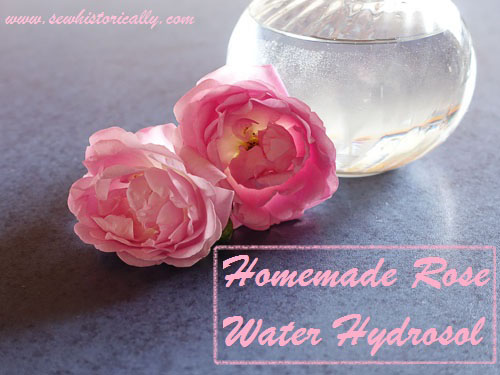
Deodorant And Antiperspirant
Since the 1888, you could buy ‘Mum’, a deodorant cream. In 1903, the first antiperspirant ‘Everdry’ was invented. It contained aluminium chloride which wasn’t very gentle to the skin and clothes (source). And since 1910, another antiperspirant ‘Odorono’ was produced. But it took some years till some Edwardians were willing to buy antiperspirants (source).
Dress Shields
Dress shields were worn to protect the dresses so that they’d need less frequent washing. Here’s a 1910 advertisement for Kleinert’s Dress Shields which can be washed and ironed, an 1870s ad for Canfield Dress Shields, and an 1904 ad for Hicks Dress Shields for the Edwardian sportswoman. In 1920, dress shields of rubber, rubberised cloth, pyroxyl, and balata were sold (Sausalito News, 1920). Dress shields can be worn in a separate layer of underwear: a pretty cotton and lace dress shield holder. But there were also many 1900 patents for dress shield fasteners: patent 1, patent 2, and patent 3. Dress shields can be washed with warm water and soap (Amador Ledger, 1909). If you want to make your own dress shields for your antique clothes, here are instructions.
Perspiration Powder
1904 advertisement for ‘Spiro Powder’: ‘Do you perspire? Then you need Spiro Powder. Of course, you perspire, you would not be healthy if you didn’t – it is as necessary to perspire as it is to have light and air. But it is not necessary to be afflicted with bodily odors – not when you have used Spiro Powder.’ (Weekly Kentucky New Era, 1904) Here’s an 1905 advertisement poster for Spiro Powder.
Perspiration Powder (The Ideal Cook Book, 1902)
- 1 oz boracic acid
- 1 drachm burnt alum
- 1/2 oz French chalk
- 6 1/2 oz starch
- 15 drops lemon oil
- 15 drops bergamot oil
‘For excessive perspiration of hands and feet, sprinkle inside of gloves or stockings, or apply under the arms with a powder puff.’
To Deodorize Perspiration Under The Arms (The Woman’s Own Book of Toilet Secrets, ca. 1896)
- bicarbonate of soda (baking soda)
Keep the soda in a tin on the dressing table. ‘After washing the parts affected dip the wet fingers in the soda and apply it freely.’ The soda kills the odor and ‘in time also decreases the quantity of perspiration.’
Homemade Deodorant (The Washington Herald, 1908)
- castile soap
- alcohol
- borated talcum
‘It is a good plan to bathe the armpits with castile suds, allowing the suds to dry on the skin, and then apply alcohol. Dust the armpits afterward with borated talcum. Dress shields should be changed every day, or with every wearing.’
Here you’ll find my Conversion Table for US, UK, and metric system units of measurement.
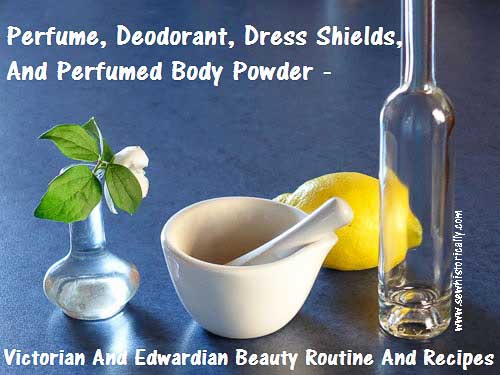
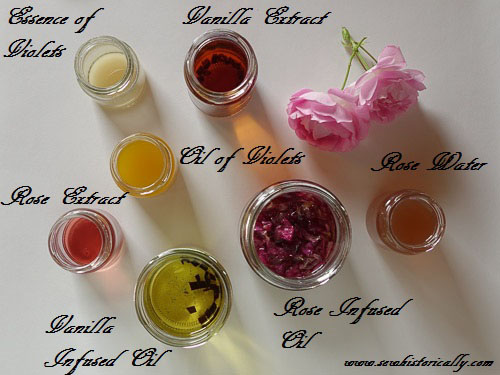
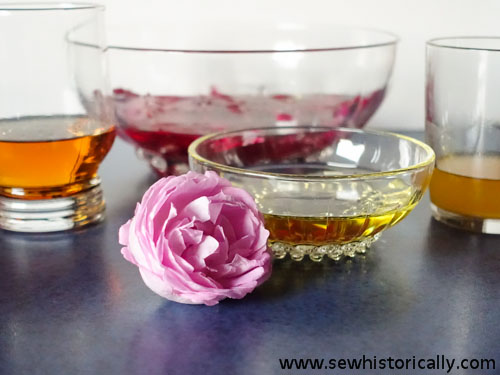

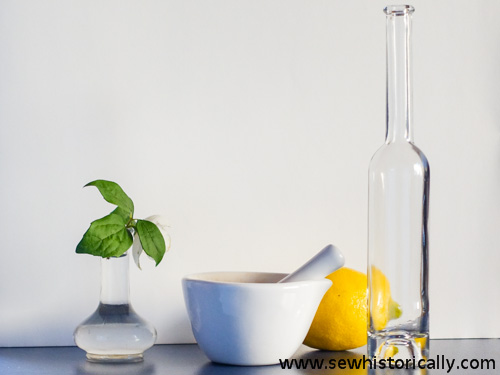
Can any of these actually work for your underarm?
Thanks for stopping by, Martha! I haven’t tried any of these as deodorant yet. But I don’t think they work as well as store-bought deodorants. However, homemade natural deodorants are always less effective than commercial ones. I think the perspiration powders might work: homemade natural deodorants are usually made with baking soda.
Thank you for the information! Is there a substitute for baking soda by any chance, or does it have to be baking soda? Is there a way that you can make natural made deodorants more effective if you add more? I would like to experiment on this.
—- Martha
I don’t think there’s a substitute for baking soda. Homemade natural deodorants are usually made with coconut oil and baking soda. If you try one of the recipes, let me know how it works. 🙂
Ok. Thank you! I’ll let you know!
— Martha
Thank you so much for these recipes. I am trying the deodorant and the natural perfumes as well. I found out the perfume I use which is very costly contains Ambergris, so I will now make my own.
Thanks for stopping by! 🙂 Please let me know if it works.